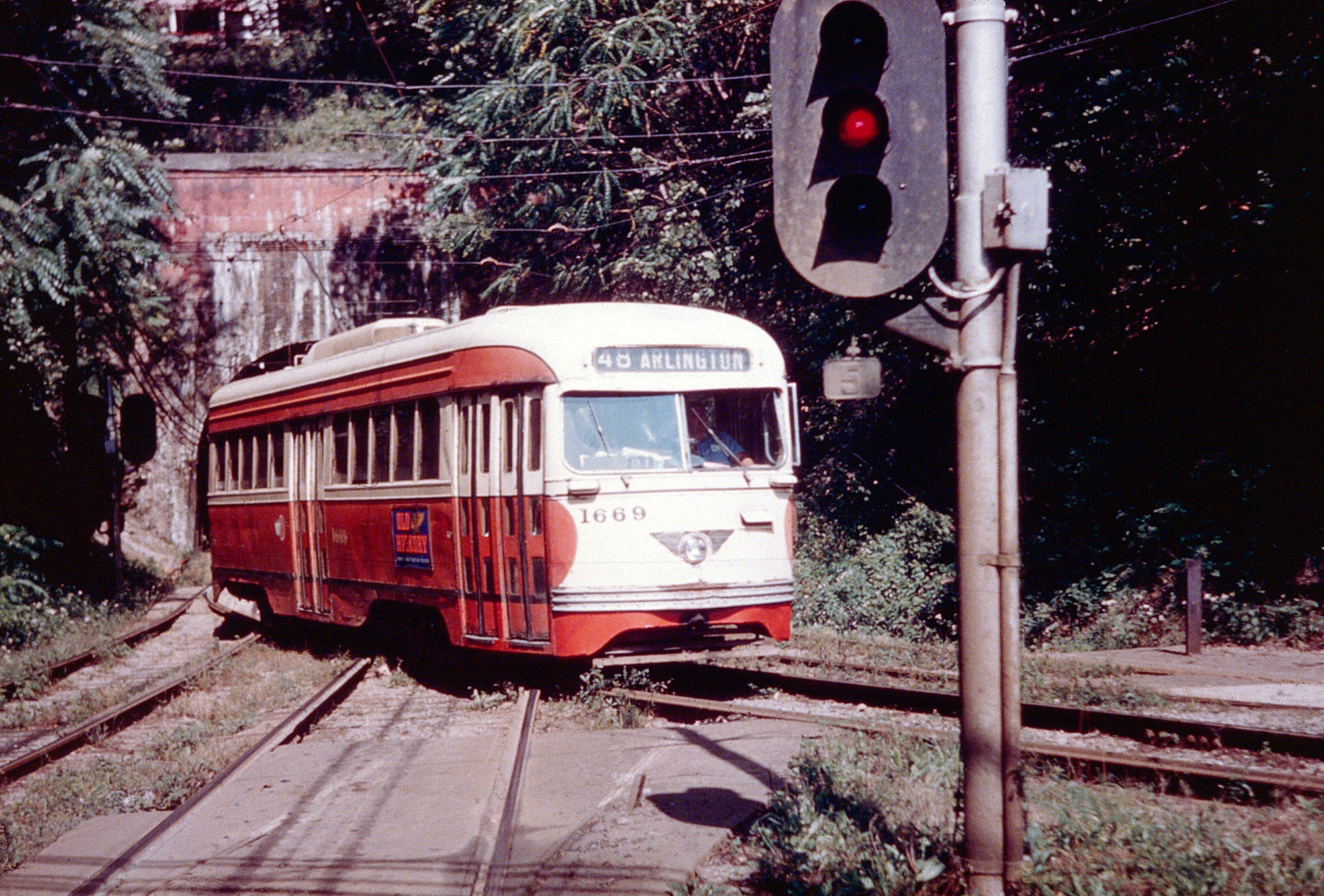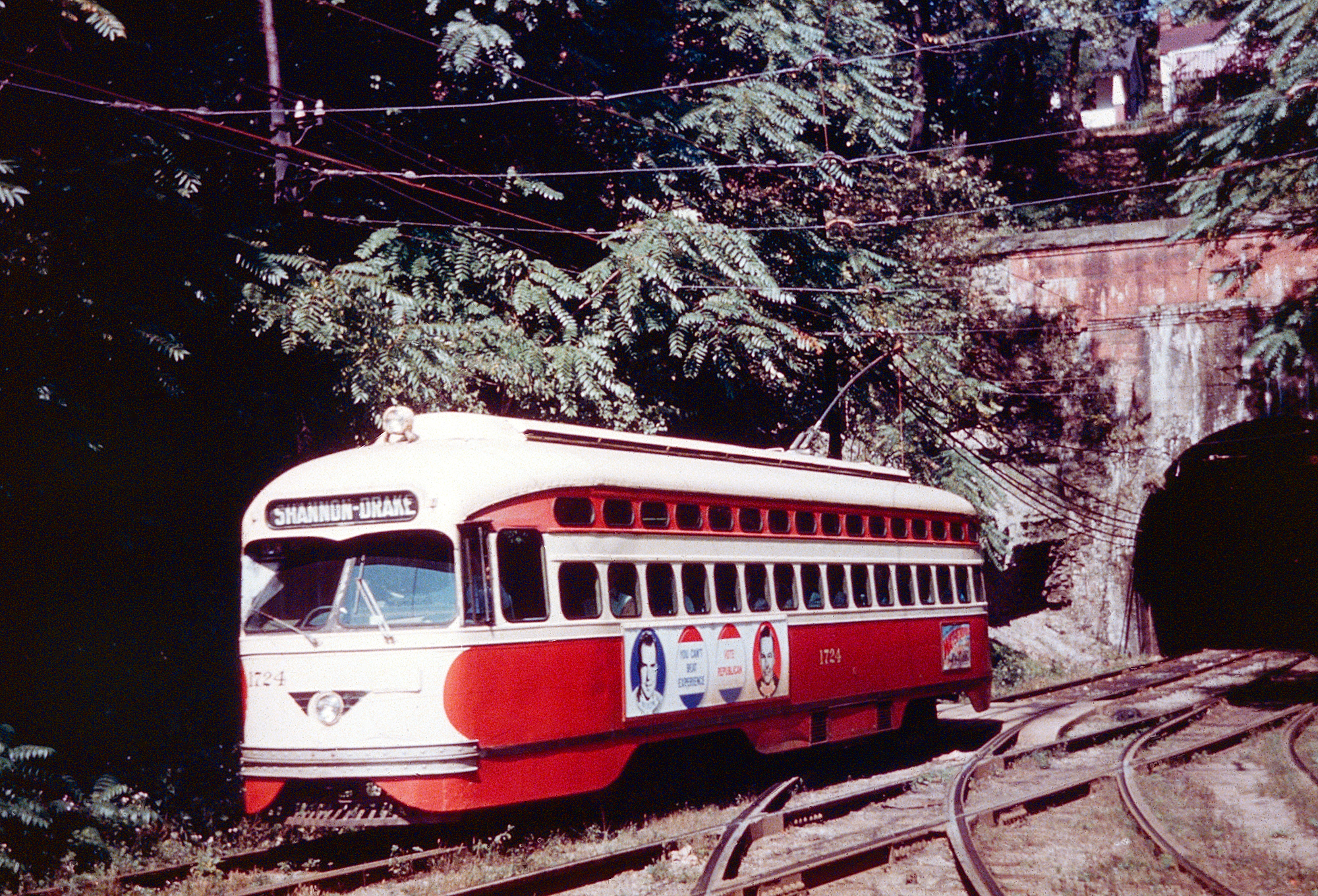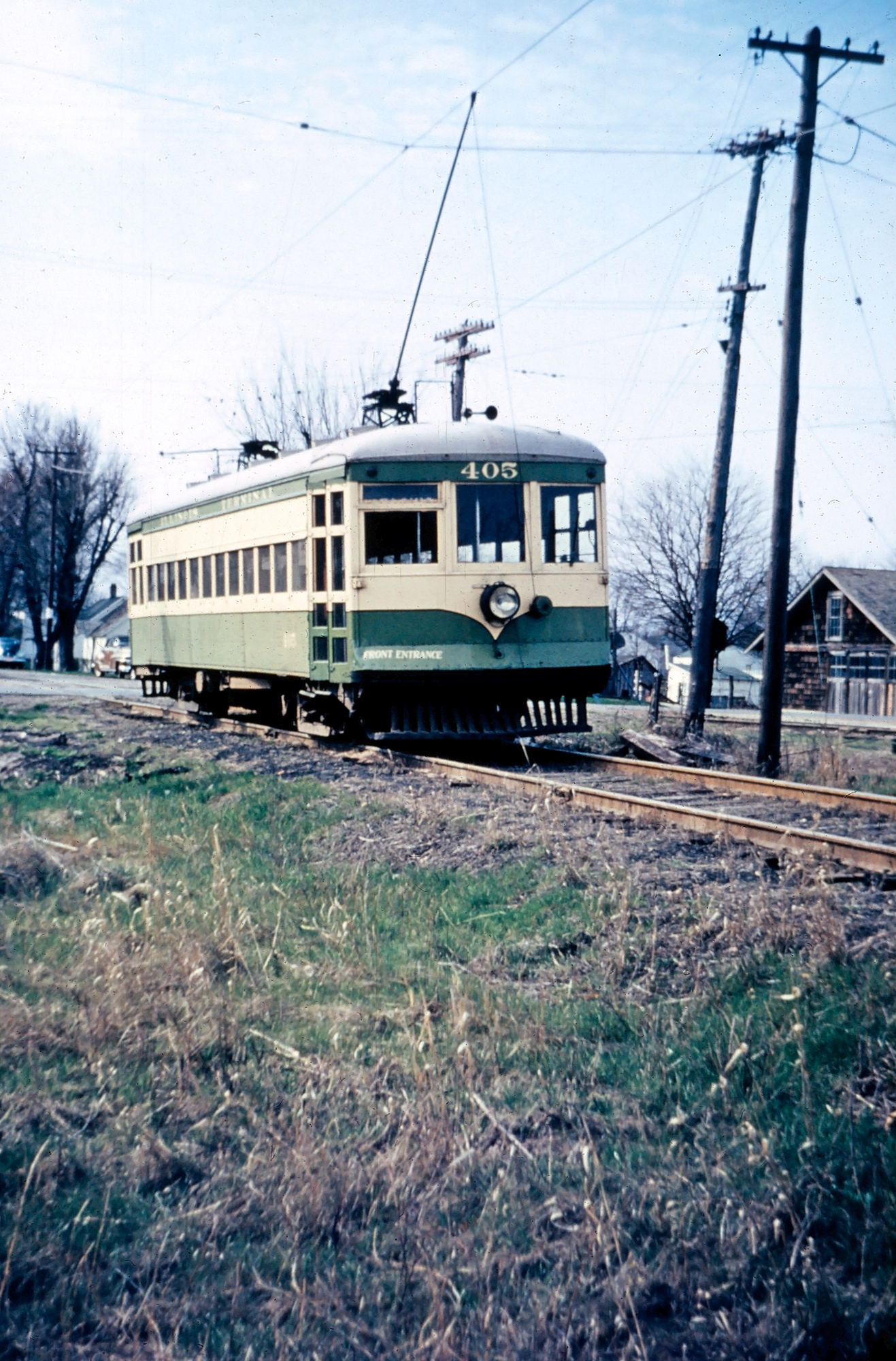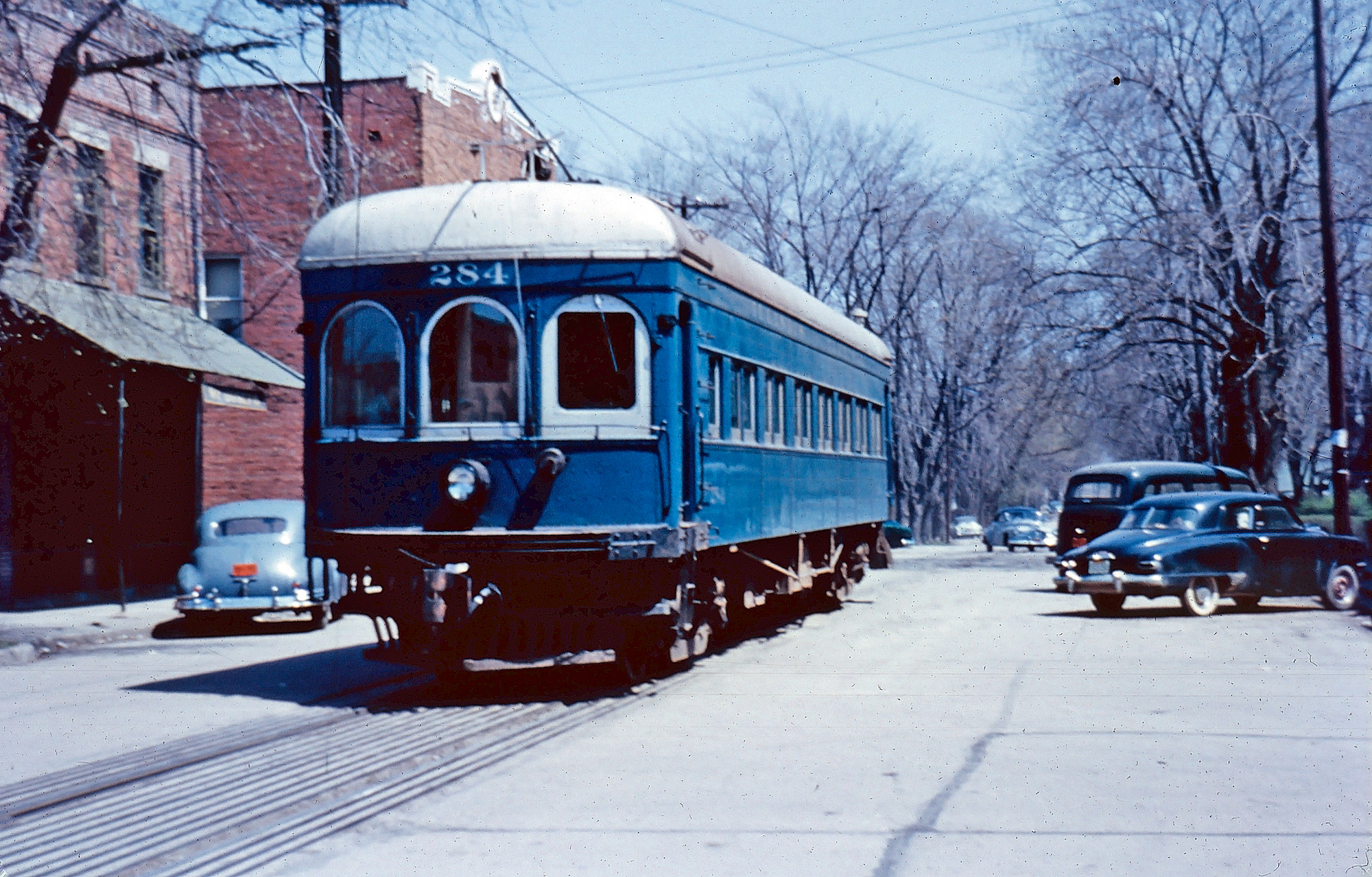St. Louis Car Company: History, Photos, Designs
Last revised: January 24, 2025
By: Adam Burns
The St. Louis Car Company was one
of the largest builders of streetcar and interurban equipment in the
industry. The company was a major competitor of other large streetcar manufacturers, like J.G. Brill and the Cincinnati Car Company.
Its location should also be noted. There were a number of builders in the St. Louis area; not surprising, when one considers Illinois and the Midwest were home to the largest concentration of interurbans and street railways in the country.
St. Louis Car built a wide range of equipment from standard interurban cars (including equipment for freight operations) to small Birneys and other streetcar designs.
Interestingly, the company was one of the longest lasting businesses which got its start building streetcars. After the industry withered away the manufacturer switched to constructing other equipment including subway cars, trolley buses, and even airplanes.
Photos
 Pittsburgh Railways PCC #1669 (a 1944 product of the St. Louis Car Company) exits from the Mt. Washington Tunnel during the early 1960s. American-Rails.com collection.
Pittsburgh Railways PCC #1669 (a 1944 product of the St. Louis Car Company) exits from the Mt. Washington Tunnel during the early 1960s. American-Rails.com collection.History
St. Louis Car was officially founded on April 4, 1887 in its home city as a means to serve the growing demand for streetcar, and later interurban, services.
Even though the operation postdated the J.G Brill Company by nearly 20 years it nevertheless became one of the industry leaders. Like Brill, St. Louis Car started off building small two-axle horse and electric street cars.
To do so it constructed a nearly 50,000 square-foot building very near the Mississippi River, strategically located to receive shipments of logs and lumber, used in the construction of its cars.
By August of 1887 the company was in full production and by the end of the year had either taken orders for or built some 400 cars of various design.
At A Glance
From its outset the St. Louis Car Company focused almost exclusively on streetcar and interurban equipment, unlike some other competitors (notably J.G. Brill) that also dabbled in main line railroad equipment for a time.
After less than three years in business the company had to expand its plant facility in 1890 to keep up with the demand. Expansion was again needed by later that decade and to do so St. Louis purchased the newly formed Union Car Company located in Baden, just north of the city.
Still unable to keep up with growing demand new buildings were constructed constructed around the turn of the century and in 1902 the company purchased another competitor, the Laclede Car Company also located in St. Louis.
20th Century
During the company's early years it primarily built cars custom-ordered for each particular streetcar system or interurban.
However, this changed in later years as St. Louis began cataloging its own line of cars such as convertibles (which had panels that could be removed allowing for open-air riding in the warmer months) and freight equipment for interurbans.
The latter was particularly true in the first decade of the 20th century as the interurban industry began to take off providing St. Louis, and all car builders at the time another market in which to sell their products.
 Pittsburgh Railways PCC #1724 (a 1949 product of the St. Louis Car Company) exits from the Mt. Washington Tunnel during the early 1960s. The PRC was a big proponent of the PCC, owning 666 examples, the third-most in North America. American-Rails.com collection.
Pittsburgh Railways PCC #1724 (a 1949 product of the St. Louis Car Company) exits from the Mt. Washington Tunnel during the early 1960s. The PRC was a big proponent of the PCC, owning 666 examples, the third-most in North America. American-Rails.com collection.Of course, it should be noted that in general, car manufacturers focused mostly on streetcar equipment as there was almost always a greater demand for such.
The only time in which this was not the case was during the period around 1909. That year, some 1,245 power cars were constructed only for interurbans, which made up a full 50% of all built.
However, as the industry began to decline 10 years later new orders quickly fell away and by 1920 interurban sales made up just 10% of all equipment built.
 Illinois Terminal car #405 is on the Forsyth Line near Forsyth, Illinois, in the spring of 1952. This car was originally built for the Chicago & Illinois Valley (Chicago, Ottawa & Peoria), and acquired by Illinois Traction in 1923 when it became part of the latter's Illinois Valley Division. American-Rails.com collection.
Illinois Terminal car #405 is on the Forsyth Line near Forsyth, Illinois, in the spring of 1952. This car was originally built for the Chicago & Illinois Valley (Chicago, Ottawa & Peoria), and acquired by Illinois Traction in 1923 when it became part of the latter's Illinois Valley Division. American-Rails.com collection.St. Louis Car built a wide range of cars during the 20th century, most of which as aforementioned centered around streetcars. However, the company also made handsome profits through the construction of the popular PCC streetcar (the Presidents' Conference Committee car) and the Birney Safety Car.
Its most prominent design was the Chicago, North Shore & Milwaukee's streamlined Electroliner trainsets of 1941. These beautiful articulated cars remained in use on the North Shore Line for nearly 20 years before being retired and were one of the final orders placed by an interurban for new equipment.
 Illinois Terminal car #284 is seen here on East Lincoln Street in St. Joseph, Illinois, circa 1950. Service along the Danville line ended entirely a few years after this photo was taken (cutback to Ogden in 1952, then Champaign a year later). This car was a product of the St. Louis Car Company. James Stitzel photo. American-Rails.com collection.
Illinois Terminal car #284 is seen here on East Lincoln Street in St. Joseph, Illinois, circa 1950. Service along the Danville line ended entirely a few years after this photo was taken (cutback to Ogden in 1952, then Champaign a year later). This car was a product of the St. Louis Car Company. James Stitzel photo. American-Rails.com collection.General Steel Industries
As the streetcar and interurban industry died away by the 1940s St. Louis Car switched to building other equipment including buses, trolley buses, and even some automobiles. During World War II it built gliders, Alligators (also known as a Landing Vehicle Tracked or LVT), and the flying boat seaplane.
As the remaining interurban industry largely disappeared after World War II, so too did remaining manufacturers and other companies supporting it. As Dr. George Hilton and John Due note in their book, "The Electric Interurban Railways In America," after the war the St. Louis Car Company was the only remaining manufacturer still producing streetcar and interurban equipment.
In 1960 the company was purchased by General Steel Industries and during its final years in business constructed subway and MU cars for agencies such as New York City Subway (NYCT), Port Authority Trans-Hudson (PATH), and the Southeastern Pennsylvania Transportation Authority (SEPTA). With a shrinking market and demand, the company finally closed its doors in 1973 after nearly 100 years of continuous production.
It is interesting to wonder what may have become of this company had it survived just a little longer when rapid transit systems slowly began making a comeback in large cities across the country. Nevertheless, a great deal of former St. Louis equipment survives today, such as the famous Electroliners.
Recent Articles
-
Wisconsin's Dinner Train Rides In North Freedom!
Jan 20, 26 01:55 PM
Featured here is a practical guide to Mid-Continent’s dining train concept—what the experience is like, the kinds of menus the museum has offered, and what to expect when you book. -
New York's Dinner Train Rides In The Adirondacks!
Jan 20, 26 12:41 PM
Operating over a restored segment of the former New York Central’s Adirondack Division, the Adirondack Railroad has steadily rebuilt both track and public interest in passenger rail across the region. -
Pennsylvania "Dinner Train" Rides In Boyertown!
Jan 20, 26 12:04 PM
With beautifully restored vintage equipment, carefully curated menus, and theatrical storytelling woven into each trip, the Colebrookdale Railroad offers far more than a simple meal on rails. -
New York ~ Murder Mystery ~ Dinner Train Rides
Jan 20, 26 12:03 PM
New York State, renowned for its vibrant cities and verdant countryside, offers a plethora of activities for locals and tourists alike, including murder mystery train rides! -
Pennsylvania ~ Murder Mystery ~ Dinner Train Rides
Jan 20, 26 11:48 AM
Pennsylvania, steeped in history and industrial heritage, offers a prime setting for a unique blend of dining and drama: the murder mystery dinner train ride. -
Florida Valentine's Train Rides
Jan 20, 26 11:46 AM
For couples looking for something different this Valentine’s Day, the museum’s signature romantic event is back: the Valentine Limited, returning February 14, 2026—a festive evening built around a tra… -
Connecticut Valentine's Train Rides
Jan 20, 26 11:43 AM
Operated by the Valley Railroad Company, the attraction has been welcoming visitors to the lower Connecticut River Valley for decades, preserving the feel of classic rail travel while packaging it int… -
Texas Dinner Train Rides At The TSR!
Jan 19, 26 12:30 PM
Today, TSR markets itself as a round-trip, four-hour, 25-mile journey between Palestine and Rusk—an easy day trip (or date-night centerpiece) with just the right amount of history baked in. -
Iowa's Dinner Train Rides In Boone!
Jan 19, 26 12:28 PM
If you’ve ever wished you could pair a leisurely rail journey with a proper sit-down meal—white tablecloths, big windows, and countryside rolling by—the Boone & Scenic Valley Railroad & Museum… -
Ohio Dinner Train Rides At The CVSR!
Jan 19, 26 12:27 PM
While the railroad is well known for daytime sightseeing and seasonal events, one of its most memorable offerings is its evening dining program—an experience that blends vintage passenger-car ambience… -
Missouri's Dinner Train Rides In Branson!
Jan 19, 26 12:21 PM
Nestled in the heart of the Ozarks, the Branson Scenic Railway offers one of the most distinctive rail experiences in the Midwest—pairing classic passenger railroading with sweeping mountain scenery a… -
Virginia Valentine's Train Rides
Jan 19, 26 12:15 PM
If you’ve ever wanted to slow life down to the rhythm of jointed rail—coffee in hand, wide windows framing pastureland, forests, and mountain ridges—the Virginia Scenic Railway (VSR) is built for exac… -
Maryland Valentine's Train Rides
Jan 19, 26 12:12 PM
The Western Maryland Scenic Railroad (WMSR) delivers one of the East’s most “complete” heritage-rail experiences: and also offer their popular dinner train during the Valentine's Day weekend. -
Indiana's Dinner Train Rides In Jasper!
Jan 18, 26 01:54 PM
In the rolling hills of southern Indiana, the Spirit of Jasper offers one of those rare attractions that feels equal parts throwback and treat-yourself night out: a classic excursion train paired with… -
New Mexico's Dinner Train Rides
Jan 18, 26 01:37 PM
If your heart is set on clinking glasses while the desert glows at sunset, you can absolutely do that here—just know which operator offers what, and plan accordingly. -
New Hampshire ~ Murder Mystery ~ Dinner Train Rides
Jan 18, 26 01:10 PM
The state's murder mystery trains stand out as a captivating blend of theatrical drama, exquisite dining, and scenic rail travel. -
New York Valentine's Train Rides
Jan 18, 26 12:32 PM
At its best, the Adirondack Railroad delivers exactly what railfans and casual riders alike hope for: vintage coaches, classic depots, rivers and forests right outside the window. -
Washington Valentine's Train Rides
Jan 18, 26 10:50 AM
Whether you’re a dedicated railfan chasing preserved equipment or a couple looking for a memorable night out, CCR&M offers a “small railroad, big experience” vibe—one that shines brightest on its spec… -
Colorado Valentine's Train Rides
Jan 18, 26 10:49 AM
The Royal Gorge Route Railroad is the kind of trip that feels tailor-made for railfans and casual travelers alike, including during Valentine's weekend. -
Georgia Valentine's Train Rides
Jan 18, 26 10:42 AM
f you’ve ridden the SAM Shortline, it’s easy to think of it purely as a modern-day pleasure train—vintage cars, wide South Georgia skies, and a relaxed pace that feels worlds away from interstates and… -
New Jersey ~ Murder Mystery ~ Dinner Train Rides
Jan 17, 26 01:16 PM
There are currently no murder mystery dinner trains available in New Jersey although until 2023 the Cape May Seashore Lines offered this event. Perhaps they will again soon! -
West Virginia Dinner Train Rides In Elkins!
Jan 17, 26 01:08 PM
The D&GV offers the kind of rail experience that feels purpose-built for railfans and casual travelers. -
Virginia Dinner Train Rides In Staunton!
Jan 17, 26 11:55 AM
If you’ve ever wished you could pair a classic scenic train ride with a genuinely satisfying meal—served at your table while the countryside rolls by—the Virginia Scenic Railway was built for you. -
Florida Easter Train Rides
Jan 17, 26 10:23 AM
The cold weather rarely invades Florida and the state nearly always warm and balmy early spring temperatures. Learn more about where you can find Easter-themed train rides across the Sunshine State. -
Ohio Easter Train Rides
Jan 17, 26 10:13 AM
Ohio is home to several museums and excursion trains preserving the state's rich railroading heritage. A few of these locations host Easter-themed train rides each spring. -
Massachusetts Valentine's Train Rides
Jan 17, 26 09:58 AM
The Cape Cod Central Railroad (CCCR) blends classic New England scenery with heritage equipment, narrated sightseeing, and some of the region’s best-known “rails-and-meals” experiences. -
California Valentine's Train Rides
Jan 17, 26 09:53 AM
Operating out of West Sacramento, this excursion railroad has built a calendar that blends scenery with experiences—wine pours, themed parties, dinner-and-entertainment outings, and seasonal specials… -
South Carolina Dinner Train Rides
Jan 16, 26 11:13 PM
There is only location in the Palmetto State offering a true dinner train experience can be found at the South Carolina Railroad Museum. Learn more here. -
Rhode Island Dinner Train Rides
Jan 16, 26 11:01 PM
Despite its small size, Rhode Island is home to one popular dinner train experience where guests can enjoy the breathtaking views of Aquidneck Island. -
Pennsylvania's Thomas The Train Rides
Jan 16, 26 04:13 PM
"A Day Out With Thomas” train rides offer a unique opportunity for children and their families to engage in a magical and memorable experience, setting the stage for a full day of fun and adventure. -
Illinois's Thomas The Train Rides
Jan 16, 26 02:23 PM
In Illinois, the "A Day Out With Thomas" event offers a unique chance for families to immerse themselves in the enchanting world of Thomas and friends, creating memories that last a lifetime. -
New Jersey's Thomas The Train Rides
Jan 16, 26 02:11 PM
Here's a comprehensive guide to what you can expect at Day Out With Thomas events in New Jersey. -
Texas ~ Murder Mystery ~ Dinner Train Rides
Jan 16, 26 01:54 PM
Here’s a comprehensive look into the world of murder mystery dinner trains in Texas. -
Connecticut ~ Murder Mystery ~ Dinner Train Rides
Jan 16, 26 01:26 PM
All aboard the intrigue express! One location in Connecticut typically offers a unique and thrilling experience for both locals and visitors alike, murder mystery trains. -
New Hampshire Dinner Train Rides In N. Conway!
Jan 16, 26 10:47 AM
Tucked into the heart of New Hampshire’s Mount Washington Valley, the Conway Scenic Railroad is one of New England’s most beloved heritage railways -
Oregon Dinner Train Rides Near Mt. Hood!
Jan 16, 26 10:44 AM
The Mt. Hood Railroad is the moving part of that postcard—a century-old short line that began as a working railroad. -
Maryland's - Wine Tasting - Train Rides
Jan 15, 26 02:59 PM
This article delves into the enchanting world of wine tasting train experiences in Maryland, providing a detailed exploration of their offerings, history, and allure. -
Colorado's - Wine Tasting - Train Rides
Jan 15, 26 02:46 PM
To truly savor these local flavors while soaking in the scenic beauty of Colorado, the concept of wine tasting trains has emerged, offering both locals and tourists a luxurious and immersive indulgenc… -
Iowa ~ Wine Tasting ~ Train Rides
Jan 15, 26 02:36 PM
The state not only boasts a burgeoning wine industry but also offers unique experiences such as wine by rail aboard the Boone & Scenic Valley Railroad. -
Georgia's Wine Train Rides In Cordele!
Jan 15, 26 02:26 PM
While the railroad offers a range of themed trips throughout the year, one of its most crowd-pleasing special events is the Wine & Cheese Train—a short, scenic round trip designed to feel like a t… -
Indiana ~ Murder Mystery ~ Dinner Train Rides
Jan 15, 26 02:22 PM
This piece explores the allure of murder mystery trains and why they are becoming a must-try experience for enthusiasts and casual travelers alike. -
Ohio ~ Murder Mystery ~ Dinner Train Rides
Jan 15, 26 02:10 PM
The murder mystery dinner train rides in Ohio provide an immersive experience that combines fine dining, an engaging narrative, and the beauty of Ohio's landscapes. -
Nevada Dinner Train Rides In Ely!
Jan 15, 26 02:01 PM
If you’ve ever wished you could step through a time portal into the hard-working world of a 1900s short line the Nevada Northern Railway in Ely is about as close as it gets. -
Michigan Dinner Train Rides In Owosso!
Jan 15, 26 09:46 AM
The Steam Railroading Institute is best known as the home of Pere Marquette #1225 and even occasionally hosts a dinner train! -
Arizona's - Wine Tasting - Train Rides
Jan 14, 26 02:04 PM
For those who want to experience the charm of Arizona's wine scene while embracing the romance of rail travel, wine tasting train rides offer a memorable journey through the state's picturesque landsc… -
Arkansas's - Wine Tasting - Train Rides
Jan 14, 26 01:57 PM
This article takes you through the experience of wine tasting train rides in Arkansas, highlighting their offerings, routes, and the delightful blend of history, scenery, and flavor that makes them so… -
Tennessee ~ Murder Mystery ~ Dinner Train Rides
Jan 14, 26 01:42 PM
Amidst the rolling hills and scenic landscapes of Tennessee, an exhilarating and interactive experience awaits those with a taste for mystery and intrigue. -
California ~ Murder Mystery ~ Dinner Train Rides
Jan 14, 26 01:26 PM
When it comes to experiencing the allure of crime-solving sprinkled with delicious dining, California's murder mystery dinner train rides have carved a niche for themselves among both locals and touri… -
Illinois ~ Murder Mystery ~ Dinner Train Rides
Jan 14, 26 01:13 PM
Among Illinois's scenic train rides, one of the most unique and captivating experiences is the murder mystery excursion. -
Vermont's - Murder Mystery - Dinner Train Rides
Jan 14, 26 12:57 PM
There are currently murder mystery dinner trains offered in Vermont but until recently the Champlain Valley Dinner Train offered such a trip!
Sources
- Hilton, George and Due, John. Electric Interurban Railways in America, The. Stanford: Stanford University Press, 2000.
- Middleton, William D. Traction Classics: The Interurbans, Extra Fast And Extra Fare. San Marino: Golden West Books, 1985.
- Middleton, William D. Traction Classics: The Interurbans, Interurban Freight. San Marino: Golden West Books, 1985.















































